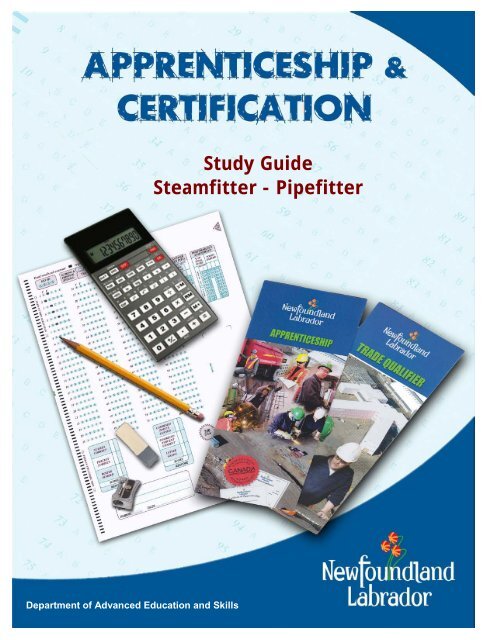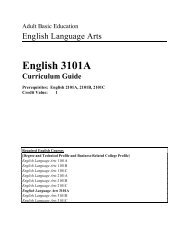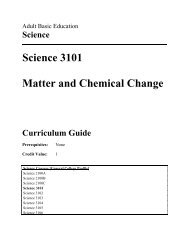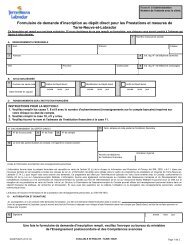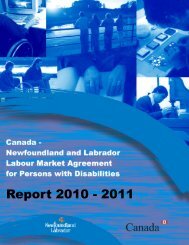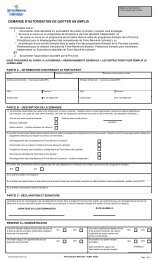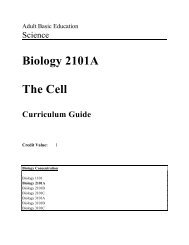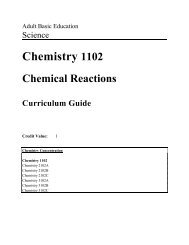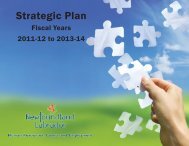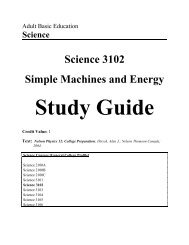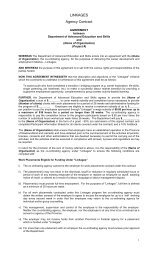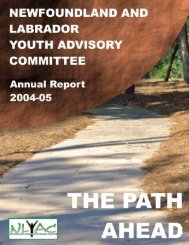Study Guide Steamfitter - Pipefitter - Department of Advanced ...
Study Guide Steamfitter - Pipefitter - Department of Advanced ...
Study Guide Steamfitter - Pipefitter - Department of Advanced ...
You also want an ePaper? Increase the reach of your titles
YUMPU automatically turns print PDFs into web optimized ePapers that Google loves.
<strong>Department</strong> <strong>of</strong> <strong>Advanced</strong> Education and Skills<br />
<strong>Study</strong> <strong>Guide</strong><br />
<strong>Steamfitter</strong> - <strong>Pipefitter</strong>
Apprenticeship and Certification<br />
<strong>Study</strong> <strong>Guide</strong><br />
<strong>Steamfitter</strong>/<strong>Pipefitter</strong><br />
(Based on 2010 NOA)<br />
Government <strong>of</strong> Newfoundland and Labrador<br />
<strong>Department</strong> <strong>of</strong> <strong>Advanced</strong> Education and Skills<br />
Apprenticeship and Trades Certification Division<br />
2010<br />
Version 3<br />
February, 2013
Table <strong>of</strong> Contents<br />
Introduction .................................................................................................................................... 2<br />
Exam Process .................................................................................................................................. 3<br />
Before the Exam.......................................................................................................................... 3<br />
During the Exam .......................................................................................................................... 3<br />
After the Exam ............................................................................................................................ 3<br />
Exam Format ................................................................................................................................... 4<br />
Exam Content .................................................................................................................................. 8<br />
Understanding the National Occupational Analysis (NOA) ........................................................ 8<br />
Exam Breakdown ........................................................................................................................ 9<br />
NOA Sub-tasks........................................................................................................................... 10<br />
Task Pr<strong>of</strong>ile Checklist ................................................................................................................ 11<br />
Create a <strong>Study</strong> Plan ....................................................................................................................... 17<br />
Resources - Websites .................................................................................................................... 18<br />
Resources – Book List.................................................................................................................... 19<br />
Conclusion ..................................................................................................................................... 20<br />
Appendices:<br />
Appendix A: Regional Offices ................................................................................................ 21<br />
Appendix B: Calculator Use ................................................................................................... 22<br />
Appendix C: Answer Sheet Example ..................................................................................... 23<br />
<strong>Study</strong> <strong>Guide</strong>_SFPF_2010 1
Introduction<br />
This <strong>Study</strong> <strong>Guide</strong> has been developed by the Newfoundland and Labrador <strong>Department</strong> <strong>of</strong><br />
<strong>Advanced</strong> Education and Skills, Apprenticeship and Trades Certification Division, to assist<br />
apprentices and trade qualifiers as they prepare to write the Interprovincial (IP) Red Seal Exam.<br />
IP Exams are available for all Red Seal trades. For a list <strong>of</strong> Interprovincial trades please refer to<br />
the <strong>Department</strong> <strong>of</strong> <strong>Advanced</strong> Education and Skills website:<br />
www.ed.gov.nl.ca/app/trades.html<br />
Some <strong>of</strong> the specific goals <strong>of</strong> this guide are:<br />
to help you understand the skills and knowledge that might be covered on the exam<br />
to help you identify your strengths and weaknesses<br />
to provide organization and structure for a course <strong>of</strong> study<br />
to provide a list <strong>of</strong> resources to help you with your study plan<br />
to support and supplement the teaching and learning process<br />
This study guide outlines the theoretical portion <strong>of</strong> the program. The intent is not to replace<br />
technical training provided under the guidance <strong>of</strong> instructors. Rather, it is a tool to be used in<br />
conjunction with formal training.<br />
2 <strong>Study</strong> <strong>Guide</strong>_SFPF_2010
Exam Process<br />
Before the Exam<br />
You must contact the nearest Apprenticeship and Trades Certification Divisional <strong>of</strong>fice to make<br />
request to write the IP Red Seal exam (See Appendix A for a list <strong>of</strong> regional <strong>of</strong>fices). Upon<br />
approval, the Program Development Officer (PDO) will notify you <strong>of</strong> your eligibility to write the<br />
exam, and provide you with scheduling information. If you require special accommodations<br />
due to a disability or language barrier, please contact your regional <strong>of</strong>fice for information on<br />
applying for this service.<br />
During the Exam<br />
You must bring:<br />
personal identification such as a photo or signature ID or valid Newfoundland<br />
and Labrador driver’s license<br />
your notification letter<br />
The following will be provided:<br />
a calculator (see Appendix B for calculator information)<br />
all other items required such as pencils, scrap paper, etc.<br />
Important Note:<br />
Personal cell phones, calculators, or other electronic equipment are NOT allowed into the<br />
exam room. If you do bring them, they will be stored away and returned to you when you<br />
have completed the exam.<br />
After the Exam<br />
Results will be mailed to you approximately seven to ten days after completion <strong>of</strong> the exam. All<br />
necessary instructions and information will be provided in the results letter.<br />
The percentage mark you obtained will be provided. You will also be given a section by section<br />
breakdown, showing how many questions were in each section, as well as the number <strong>of</strong><br />
questions in each section you completed successfully.<br />
If you are successful in obtaining a 70% or more on your exam, you will be issued a<br />
Newfoundland and Labrador Certificate <strong>of</strong> Qualification with a Red Seal endorsement.<br />
<strong>Study</strong> <strong>Guide</strong>_SFPF_2010 3
Exam Format<br />
All IP Red Seal exams are written in multiple-choice format. Each exam has between 100 and<br />
150 questions. A multiple choice question consists <strong>of</strong> a stem (a complete question) followed by<br />
four options (A, B, C, D). The stem contains all the information necessary to answer the<br />
question. The options consist <strong>of</strong> the one correct answer and three “distracters.” Distracters<br />
are incorrect. (See Appendix C for a sample answer sheet).<br />
IP Red Seal exams contain three types <strong>of</strong> questions:<br />
Level 1 Knowledge and Recall<br />
Questions at this level test your ability to recall and understand definitions, facts,<br />
and principles.<br />
Level 2 Procedural and Application<br />
Questions at this level test your ability to apply your knowledge <strong>of</strong> procedures to<br />
a new situation.<br />
Level 3 Critical Thinking<br />
Questions at this level test your ability to interpret data, solve problems and<br />
arrive at valid conclusions.<br />
Level 1 Examples:<br />
4 <strong>Study</strong> <strong>Guide</strong>_SFPF_2010
Level 2 Examples:<br />
<strong>Study</strong> <strong>Guide</strong>_SFPF_2010 5
Level 3 Examples:<br />
6 <strong>Study</strong> <strong>Guide</strong>_SFPF_2010
Source <strong>of</strong> questions:<br />
www.itabc.ca/page30.aspx<br />
www.tradesecrets.gov.ab.ca/trades/pdf/trade_practice_exams/007_IP_PracticeExam.pdf<br />
<strong>Study</strong> <strong>Guide</strong>_SFPF_2010 7
Exam Content<br />
Understanding the National Occupational Analysis (NOA)<br />
The NOA is a document used for Red Seal trades that describes the knowledge, skills and<br />
abilities required by a fully competent tradesperson working in that trade. The content for the<br />
IP Red Seal exam is based on the NOA. The NOA is an excellent tool to use as you study for the<br />
Red Seal exam. NOAs can be found at www.red-seal.ca.<br />
NOA material is organized into major content areas called BLOCKS. The blocks are further<br />
broken down into TASKS and SUB-TASKS.<br />
NOA<br />
NOA Pie Chart<br />
Blocks<br />
Blocks<br />
Tasks<br />
The NOA Pie Chart presents the block percentages in the form <strong>of</strong> a pie chart which tells you the<br />
approximate number <strong>of</strong> questions from each block. For example, 10% <strong>of</strong> the questions on the<br />
<strong>Steamfitter</strong>/<strong>Pipefitter</strong> Exam will be based on Block A.<br />
<strong>Steamfitter</strong>/<strong>Pipefitter</strong><br />
Sub-tasks<br />
Block Titles<br />
Block A Occupational Skills Block F Heating, Cooling and Process System Installation<br />
Block B Drawings and Specifications Block G Renewable Energy System Installation<br />
Block C Layout, Fabrication and Installation Block H Testing and Commissioning<br />
Block D Rigging and Hoisting Block I Maintenance and Repair<br />
Block E Steam System Installation<br />
8 <strong>Study</strong> <strong>Guide</strong>_SFPF_2010
Exam Breakdown<br />
The <strong>Steamfitter</strong>/<strong>Pipefitter</strong> exam currently has 130 questions. The following table shows a<br />
breakdown <strong>of</strong> the approximate number <strong>of</strong> questions that come from each NOA block. It is<br />
important to note that the number <strong>of</strong> questions can change at any time. When you are ready<br />
to write your exam you may contact your regional <strong>of</strong>fice to verify the number <strong>of</strong> questions (see<br />
Appendix A for phone numbers).<br />
Block A Occupational Skills<br />
# <strong>of</strong> Questions<br />
12<br />
Task 1 Performs safety-related functions<br />
Task 2 Uses and maintains tools and equipment<br />
Task 3 Organizes work<br />
Block B Drawings and Specifications 15<br />
Task 4 Interprets drawings and specifications<br />
Task 5 Produces drawings<br />
Block C Layout, Fabrication and Installation 19<br />
Task 6 Performs layout and fabrication<br />
Task 7 Performs common installation processes<br />
Task 8 Installs tracing systems<br />
Block D Rigging and Hoisting 14<br />
Task 9 Plans lift<br />
Task 10 Hoists load<br />
Block E Steam System Installation 22<br />
Task 11 Installs low pressure process steam systems<br />
Task 12 Installs high pressure process steam systems<br />
Task 13 Installs steam heating systems<br />
Block F Heating, Cooling and Process System Installation 22<br />
Task 14 Installs hydronic systems<br />
Task 15 Installs process piping systems<br />
Task 16 Installs hydraulic systems<br />
Task 17 Installs refrigeration systems<br />
Task 18 Installs fuel systems<br />
Task 19 Installs medical gas systems<br />
Task 20 Installs compressed air systems<br />
Block G Renewable Energy System Installation 7<br />
Task 21 Installs geo-thermal systems<br />
Task 22 Installs solar heating systems<br />
Task 23 Installs heat recovery systems<br />
Block H Testing and Commissioning 10<br />
Task 24 Prepares system for test<br />
Task 25 Performs test<br />
Task 26 Commissions systems<br />
Block I Maintenance and Repair 9<br />
Task 27 Maintains system<br />
Task 28 Performs repairs<br />
Total 130<br />
<strong>Study</strong> <strong>Guide</strong>_SFPF_2010 9
NOA Sub-tasks<br />
The following NOA Task Pr<strong>of</strong>ile Checklist outlines the blocks, tasks and sub-tasks for your trade.<br />
The IP Red Seal exam is written to test your knowledge and abilities regarding the sub-tasks in<br />
the NOA. This chart can be used to review your current knowledge. You can review by placing<br />
a checkmark () next to those you understand fully.<br />
Place your focus on those you do not understand and study them until you are comfortable<br />
with the material. Think <strong>of</strong> possible questions in that particular content area.<br />
The NOA also contains a list <strong>of</strong> “supporting knowledge and abilities” for each sub-task. They<br />
are the skills and knowledge you must have to perform a sub-task. The supporting knowledge<br />
and abilities identified under each sub-task will be very helpful as you review. The list can be<br />
found in the NOA for your trade.<br />
10 <strong>Study</strong> <strong>Guide</strong>_SFPF_2010
Block A: Occupational Skills<br />
Task Pr<strong>of</strong>ile Checklist<br />
Based on 2010 NOA<br />
<strong>Steamfitter</strong>/<strong>Pipefitter</strong><br />
Task 1: Performs Safety-Related Functions<br />
Sub-Tasks<br />
Maintains safe work environment<br />
Uses personal protective equipment (PPE) and safety equipment<br />
Task 2: Uses and Maintains Tools and Equipment<br />
Sub-Tasks<br />
Uses ladders and work platforms<br />
Maintains tools and equipment<br />
Uses welding equipment<br />
Uses soldering and brazing equipment<br />
Uses oxy-fuel equipment<br />
Task 3: Organizes Work<br />
Sub-Tasks<br />
Plans job<br />
Generates material list<br />
Performs quality control functions<br />
Block B: Drawings and Specifications<br />
Task 4: Interprets Drawings and Specifications<br />
Sub-Tasks<br />
Compares specifications to drawings<br />
Refers to types <strong>of</strong> drawings<br />
Task 5: Performs Drawings<br />
Sub-Tasks<br />
Generates drawings<br />
Develops templates<br />
<strong>Study</strong> <strong>Guide</strong>_SFPF_2010 11
Block C: Layout, Fabrication and Installation<br />
Task 6: Performs Layout and Fabrication<br />
Sub-Tasks<br />
Lays out pipe and fittings<br />
Fabricates piping spools<br />
Fabricates brackets, supports, hangers, guides and anchors<br />
Task 7: Performs Common Installation Processes<br />
Sub-Tasks<br />
Installs piping system components and equipment<br />
Installs brackets, supports, hangers, guides and anchors<br />
Task 8: Installs Tracing Systems<br />
Sub-Tasks<br />
Installs steam tracing<br />
Installs liquid-filled tracing systems<br />
Block D: Rigging and Hoisting<br />
Task 9: Plans Lift<br />
Sub-Tasks<br />
Determines load<br />
Selects rigging and hoisting equipment<br />
Prepares lift plan<br />
Task 10: Hoists Load<br />
Sub-Tasks<br />
Conducts rigging and hoisting equipment inspection<br />
Secures lift area<br />
Sets up rigging equipment<br />
Performs lift<br />
Stores equipment<br />
12 <strong>Study</strong> <strong>Guide</strong>_SFPF_2010
Block E: Steam System Installation<br />
Task 11: Installs Low Pressure Process Steam Systems<br />
Sub-Tasks<br />
Installs equipment for low pressure process steam<br />
Installs piping for low pressure process steam<br />
Task 12: Installs High Pressure Process Steam Systems<br />
Sub-Tasks<br />
Installs equipment for high pressure process steam<br />
Installs piping for high pressure process steam<br />
Task 13: Installs Steam Heating Systems<br />
Sub-Tasks<br />
Installs equipment for steam heating systems<br />
Installs piping for steam heating systems<br />
Block F: Heating, Cooling and Process System Installation<br />
Task 14: Installs Hydronic Systems<br />
Sub-Tasks<br />
Installs equipment for hydronic systems<br />
Installs piping for hydronic systems<br />
Task 15: Installs Process Piping Systems<br />
Sub-Tasks<br />
Installs equipment for process piping systems<br />
Installs piping for process piping systems<br />
<strong>Study</strong> <strong>Guide</strong>_SFPF_2010 13
Task 16: Installs Hydraulic Systems<br />
Sub-Tasks<br />
Installs equipment for hydraulic systems<br />
Installs piping and tubing for hydraulic systems<br />
Task 17: Installs Refrigeration Systems<br />
Sub-Tasks<br />
Installs equipment for refrigeration systems<br />
Installs piping and tubing for refrigeration systems<br />
Task 18: Installs Fuel Systems<br />
Sub-Tasks<br />
Installs equipment for fuel systems<br />
Installs piping for fuel systems<br />
Task 19: Installs Medical Gas Systems<br />
Sub-Tasks<br />
Installs equipment for medical gas systems<br />
Installs piping and tubing for medical gas systems<br />
Task 20: Installs Compressed Air Systems<br />
Sub-Tasks<br />
Installs equipment for compressed air systems<br />
Installs piping and tubing for compressed air systems<br />
Block G: Renewable Energy System Installation<br />
Task 21: Installs Geo-thermal Systems<br />
Sub-Tasks<br />
Installs equipment for geo-thermal systems<br />
Installs piping for geo-thermal systems<br />
14 <strong>Study</strong> <strong>Guide</strong>_SFPF_2010
Task 22: Installs Solar Heating Systems<br />
Sub-Tasks<br />
Installs equipment for solar heating systems<br />
Installs piping for solar heating systems<br />
Task 23: Installs Heat Recovery Systems<br />
Sub-Tasks<br />
Installs equipment for heat recovery systems<br />
Installs piping for heat recovery systems<br />
Block H: Testing and Commissioning<br />
Task 24: Prepares System for Test<br />
Sub-Tasks<br />
Pre-checks system for test<br />
Selects test equipment<br />
Isolates system<br />
Connects test equipment<br />
Task 25: Performs Test<br />
Sub-Tasks<br />
Secures test area<br />
Pressurizes system<br />
Inspects system<br />
Corrects leaks<br />
Removes test equipment<br />
Task 26: Commissions Systems<br />
Sub-Tasks<br />
Flushes system<br />
Chemically treats system<br />
Participates in start-up procedure<br />
<strong>Study</strong> <strong>Guide</strong>_SFPF_2010 15
Block I: Maintenance and Repair<br />
Task 27: Maintains System<br />
Sub-Tasks<br />
Follows lock-out procedures<br />
Performs preventative maintenance and service<br />
Task 28: Performs Repairs<br />
Sub-Tasks<br />
Diagnoses problems<br />
Repairs piping and components<br />
16 <strong>Study</strong> <strong>Guide</strong>_SFPF_2010
Create a <strong>Study</strong> Plan<br />
As you prepare for your exam, it is important to plan a schedule. The following two tables will<br />
help you stay on track.<br />
The first table is a “Weekly <strong>Study</strong> Plan.” In this table list the areas you will focus your study<br />
for each day. You should include items you need to review as well as items you need to study.<br />
Remember, more time will be needed for study in areas you find difficult, whereas you may<br />
only require review in areas you are more familiar with. As you work through the NOA subtask<br />
list you can start to fill in this table.<br />
The second table is a “<strong>Study</strong> Time Table.” It is important to create a study schedule where<br />
you determine the best days <strong>of</strong> the week and times <strong>of</strong> day for you to study.<br />
Print several copies <strong>of</strong> these tables and fill out for each week <strong>of</strong> study. It is important to stick<br />
to your study schedule.<br />
<strong>Study</strong> <strong>Guide</strong>_SFPF_2010 17
Weekly <strong>Study</strong> Plan for Week <strong>of</strong>: _________________________________________<br />
Mon.<br />
Tues.<br />
Wed.<br />
Thu.<br />
Fri.<br />
Sat.<br />
Sun.<br />
Area <strong>of</strong> <strong>Study</strong> 1 Area <strong>of</strong> <strong>Study</strong> 2 Area <strong>of</strong> <strong>Study</strong> 3 Area <strong>of</strong> <strong>Study</strong> 4 Area <strong>of</strong> <strong>Study</strong> 5 Area <strong>of</strong> <strong>Study</strong> 6
<strong>Study</strong> Time Table for Week <strong>of</strong>: _________________________________________<br />
8:00 AM -<br />
9:00 AM<br />
9:00 AM -<br />
10:00 AM<br />
10:00 AM -<br />
11:00 AM<br />
11:00 AM -<br />
12:00 Noon<br />
12:00 Noon<br />
1:00 PM<br />
1:00 PM -<br />
2:00 PM<br />
2:00 PM -<br />
3:00 PM<br />
3:00 PM -<br />
4:00 PM<br />
4:00 PM -<br />
5:00 PM<br />
5:00 PM -<br />
6:00 PM<br />
6:00 PM -<br />
7:00 PM<br />
7:00 PM -<br />
8:00 PM<br />
Monday Tuesday Wednesday Thursday Friday Saturday Sunday
Resources - Websites<br />
<strong>Study</strong> information can be drawn from a variety <strong>of</strong> sources. A sample list <strong>of</strong> study materials (websites<br />
and books) is provided below. These and other helpful resources may be found in a local college<br />
bookstore, on the internet, or at your place <strong>of</strong> employment. You may also be able to borrow them<br />
from an apprentice or journeyperson in your trade.<br />
<strong>Study</strong> Strategies and Exam Preparation <strong>Guide</strong><br />
The <strong>Study</strong> Strategies & Exam Preparation <strong>Guide</strong> is meant to be used in conjunction with this study guide. It<br />
provides direction and information on such areas as study habits, test preparation and test taking techniques.<br />
Plan <strong>of</strong> Training (POT)<br />
Website: www.ed.gov.nl.ca/app/publications/exam_prep_guide.pdf<br />
A Provincial Plan <strong>of</strong> Training details the full scope <strong>of</strong> learning for a particular occupation, including both technical<br />
training competencies and industry experiences necessary to write an IP Red Seal exam (and complete the<br />
requirements for Red Seal Certification), or to write a provincial examination. The Plan <strong>of</strong> Training is based on the<br />
NOA.<br />
Red Seal Website:<br />
POT Website: www.ed.gov.nl.ca/app/plans.html<br />
National Occupational Analysis - The NOA is a document used for Red Seal trades that describes the knowledge<br />
and abilities required by a fully competent tradesperson working in that trade. The content for the IP exam is<br />
based on the NOA.<br />
<strong>Steamfitter</strong>/<strong>Pipefitter</strong> PRACTICE Exams<br />
Red Seal Website: www.red-seal.ca<br />
These are NOT IP exams. They are practice exams provided by the provinces <strong>of</strong> Alberta, British Columbia and the<br />
Inter-provincial Standards Red Seal program. They were developed using similar question types to that <strong>of</strong> a Red<br />
Seal exam. The exams are intended to be used for self-assessment in preparation for writing an IP Exam.<br />
Sample questions can be found at:<br />
www.itabc.ca/page30.aspx<br />
www.tradesecrets.gov.ab.ca/trades/pdf/trade_practice_exams/007_IP_PracticeExam.pdf<br />
www.red-seal.ca/tr.1d.2ecsdeta.3l@-eng.jsp?tid=230&fid=43<br />
Glossary <strong>of</strong> Terms<br />
The Red Seal website also lists a Glossary <strong>of</strong> Terms which will be helpful in preparing for your IP exam:<br />
www.red-seal.ca/tr.1d.2n.4adeta.3l@-eng.jsp?tid=230&fid=1192<br />
18 <strong>Study</strong> <strong>Guide</strong>_SFPF_2010
Resources – Book List<br />
For the <strong>Steamfitter</strong>/<strong>Pipefitter</strong> trade, colleges use a small number <strong>of</strong> IPT books which are listed<br />
below. It is not necessary to use these books specifically, as you may find others that will be<br />
equally beneficial.<br />
IPT Books<br />
IPT’s Pipe Trades Handbook, IPT Publishing and Training Ltd. (contains some information for<br />
all NOA blocks), ISBN# 978-0-920855-18-8.<br />
IPT’s Crane and Rigging Manual, IPT Publishing and Training Ltd. (NOA block D), ISBN# 978-<br />
0920855164.<br />
<strong>Study</strong> <strong>Guide</strong>_SFPF_2010 19
Disclaimer<br />
Various external resources (websites, textbooks) have been listed in this study guide to assist an<br />
individual in preparing to write an IP Red Seal Exam. This does not mean the <strong>Department</strong> <strong>of</strong><br />
<strong>Advanced</strong> Education and Skills, Newfoundland and Labrador, endorses the material or that<br />
these are recommended as the best resources. There may be other resources <strong>of</strong> equal or<br />
greater value to an individual preparing for an IP Red Seal exam. The <strong>Department</strong> <strong>of</strong> <strong>Advanced</strong><br />
Education and Skills has no control over the content <strong>of</strong> external textbooks and websites listed,<br />
and no responsibility is assumed for the accuracy <strong>of</strong> the material.<br />
Conclusion<br />
We hope this guide has provided you with some useful tools as you prepare for your IP Red Seal<br />
exam. If you have any questions regarding your IP Red Seal exam please contact your regional<br />
<strong>of</strong>fice (see Appendix A for a list <strong>of</strong> regional <strong>of</strong>fices).<br />
We appreciate your comments and feedback regarding the usefulness <strong>of</strong> this study guide. If<br />
you have any comments or suggestions, we welcome your feedback. The feedback form at the<br />
end <strong>of</strong> this guide can be used for this purpose.<br />
20 <strong>Study</strong> <strong>Guide</strong>_SFPF_2010
Appendix A: Regional Offices<br />
If you have any questions regarding your IP Red Seal exam, please contact one <strong>of</strong> the following<br />
regional <strong>of</strong>fices:<br />
<strong>Department</strong> <strong>of</strong> <strong>Advanced</strong> Education and Skills<br />
Apprenticeship and Trades Certification Division<br />
Toll Free: 1-877-771-3737<br />
www.ed.gov.nl.ca/app/<br />
Corner Brook Grand Falls-Windsor<br />
133 Riverside Drive, 3rd Floor<br />
P.O. Box 2006<br />
Corner Brook, NL A2H 6J8<br />
Telephone: (709) 637-2366<br />
Facsimile: (709) 637-2519<br />
8 Myers Avenue, Suite 203<br />
Clarenville, NL<br />
A5A 1T5<br />
7 Queensway<br />
Grand Falls-Windsor, NL<br />
A2A 1W9<br />
Telephone: (709) 292-4215<br />
Facsimile: (709) 292-4502<br />
Clarenville St. John’s<br />
Telephone: (709) 466-3982<br />
Facsimile: (709) 466-3987<br />
Happy Valley – Goose Bay<br />
P.O. Box 3014, Station “B”<br />
Happy Valley – Goose Bay, NL<br />
A0P 1E0<br />
Telephone: (709) 896-6348<br />
Facsimile: (709) 896-3733<br />
Confederation Building<br />
P.O. Box 8700<br />
St. John’s, NL A1B 4J6<br />
Telephone: (709) 729-5688<br />
Facsimile: (709) 729-5878<br />
<strong>Study</strong> <strong>Guide</strong>_SFPF_2010 21
Appendix B: Calculator Use<br />
The picture below shows a calculator with the same functions as the one you will be provided<br />
with during your exam. It is advisable to borrow or purchase one with similar functions so that<br />
you can familiarize yourself with it before you write your exam.<br />
22 <strong>Study</strong> <strong>Guide</strong>_SFPF_2010
Appendix C: Answer Sheet Example<br />
With your exam you will be given an answer sheet similar to the one below. When answering<br />
multiple choice questions be sure to fill the circle completely and fill the circle that corresponds<br />
to the question on the exam.<br />
<strong>Study</strong> <strong>Guide</strong>_SFPF_2010 23
Please answer the following:<br />
Feedback Form<br />
<strong>Study</strong> <strong>Guide</strong> – <strong>Steamfitter</strong>/<strong>Pipefitter</strong><br />
(1) This <strong>Study</strong> <strong>Guide</strong> is a useful tool for exam preparation.<br />
strongly agree agree disagree strongly disagree<br />
(2) The topics contained in the guide are arranged in a logical order.<br />
strongly agree agree disagree strongly disagree<br />
(3) The design and format <strong>of</strong> the guide caught my attention.<br />
strongly agree agree disagree strongly disagree<br />
(4) The instructions throughout the guide are clear and to the point.<br />
strongly agree agree disagree strongly disagree<br />
(5) The resources listed in this guide are suitable and valuable.<br />
strongly agree agree disagree strongly disagree<br />
(6) The guide should contain more information.<br />
strongly agree agree disagree strongly disagree<br />
Suggested information/resources to include:<br />
Additional Comments:<br />
Please complete this form and return via fax or mail to the following:<br />
<strong>Department</strong> <strong>of</strong> <strong>Advanced</strong> Education and Skills<br />
Apprenticeship and Trades Certification Division<br />
Standards and Curriculum Unit<br />
Suite 203, 8 Myers Avenue, Clarenville, NL A5A 1T5<br />
Fax: (709) 466-3987


